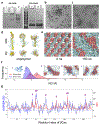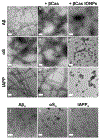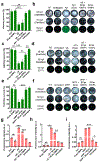Inhibition of Amyloid Aggregation and Toxicity with Janus Iron Oxide Nanoparticles
- PMID: 34887621
- PMCID: PMC8651233
- DOI: 10.1021/acs.chemmater.1c01947
Inhibition of Amyloid Aggregation and Toxicity with Janus Iron Oxide Nanoparticles
Abstract
Amyloid aggregation is a ubiquitous form of protein misfolding underlying the pathologies of Alzheimer's disease (AD), Parkinson's disease (PD) and type 2 diabetes (T2D), three primary forms of human amyloid diseases. While much has been learned about the origin, diagnosis and management of these neurological and metabolic disorders, no cure is currently available due in part to the dynamic and heterogeneous nature of the toxic oligomers induced by amyloid aggregation. Here we synthesized beta casein-coated iron oxide nanoparticles (βCas IONPs) via a BPA-P(OEGA-b-DBM) block copolymer linker. Using a thioflavin T kinetic assay, transmission electron microscopy, Fourier transform infrared spectroscopy, discrete molecular dynamics simulations and cell viability assays, we examined the Janus characteristics and the inhibition potential of βCas IONPs against the aggregation of amyloid beta (Aβ), alpha synuclein (αS) and human islet amyloid polypeptide (IAPP) which are implicated in the pathologies of AD, PD and T2D. Incubation of zebrafish embryos with the amyloid proteins largely inhibited hatching and elicited reactive oxygen species, which were effectively rescued by the inhibitor. Furthermore, Aβ-induced damage to mouse brain was mitigated in vivo with the inhibitor. This study revealed the potential of Janus nanoparticles as a new nanomedicine against a diverse range of amyloid diseases.
Keywords: Amyloid beta; IAPP; Janus nanoparticle; alpha synuclein; iron oxide nanoparticle.
Conflict of interest statement
Competing financial interests The authors declare no conflicting financial interests.
Figures








Similar articles
-
Serum albumin impedes the amyloid aggregation and hemolysis of human islet amyloid polypeptide and alpha synuclein.Biochim Biophys Acta Biomembr. 2018 Sep;1860(9):1803-1809. doi: 10.1016/j.bbamem.2018.01.015. Epub 2018 Jan 31. Biochim Biophys Acta Biomembr. 2018. PMID: 29366673
-
Lysophosphatidylcholine modulates the aggregation of human islet amyloid polypeptide.Phys Chem Chem Phys. 2017 Nov 22;19(45):30627-30635. doi: 10.1039/c7cp06670h. Phys Chem Chem Phys. 2017. PMID: 29115353 Free PMC article.
-
Differential effects of silver and iron oxide nanoparticles on IAPP amyloid aggregation.Biomater Sci. 2017 Feb 28;5(3):485-493. doi: 10.1039/c6bm00764c. Biomater Sci. 2017. PMID: 28078343
-
Phthalocyanines as Molecular Scaffolds to Block Disease-Associated Protein Aggregation.Acc Chem Res. 2016 May 17;49(5):801-8. doi: 10.1021/acs.accounts.5b00507. Epub 2016 May 2. Acc Chem Res. 2016. PMID: 27136297 Review.
-
Iron oxide nanoparticles may damage to the neural tissue through iron accumulation, oxidative stress, and protein aggregation.BMC Neurosci. 2017 Jun 26;18(1):51. doi: 10.1186/s12868-017-0369-9. BMC Neurosci. 2017. PMID: 28651647 Free PMC article. Review.
Cited by
-
Endothelial leakiness elicited by amyloid protein aggregation.Nat Commun. 2024 Jan 19;15(1):613. doi: 10.1038/s41467-024-44814-1. Nat Commun. 2024. PMID: 38242873 Free PMC article.
-
A cationic amphiphilic peptide chaperone rescues Aβ42 aggregation and cytotoxicity.RSC Med Chem. 2022 Dec 10;14(2):332-340. doi: 10.1039/d2md00414c. eCollection 2023 Feb 22. RSC Med Chem. 2022. PMID: 36846376 Free PMC article.
-
Zinc and pH modulate the ability of insulin to inhibit aggregation of islet amyloid polypeptide.Commun Biol. 2024 Jun 27;7(1):776. doi: 10.1038/s42003-024-06388-y. Commun Biol. 2024. PMID: 38937578 Free PMC article.
-
Spike Protein Fragments Promote Alzheimer's Amyloidogenesis.ACS Appl Mater Interfaces. 2023 Aug 30;15(34):40317-40329. doi: 10.1021/acsami.3c09815. Epub 2023 Aug 16. ACS Appl Mater Interfaces. 2023. PMID: 37585091 Free PMC article.
-
Islet amyloid polypeptide fibril catalyzes amyloid-β aggregation by promoting fibril nucleation rather than direct axial growth.Int J Biol Macromol. 2024 Nov;279(Pt 1):135137. doi: 10.1016/j.ijbiomac.2024.135137. Epub 2024 Aug 27. Int J Biol Macromol. 2024. PMID: 39208885
References
-
- Hartl FU; Hayer-Hartl M, Converging concepts of protein folding in vitro and in vivo. Nat. Struct. Mol. Biol 2009, 16, 574–581. - PubMed
-
- Clark A; Lewis CE; Willis AC; Cooper GJS; Morris JF; Reid KBM; Turner RC, Islet amyloid formed from diabetes-associated peptide may be pathogenic in type-2 diabetes. The Lancet 1987, 330, 231–234. - PubMed
Grants and funding
LinkOut - more resources
Full Text Sources
